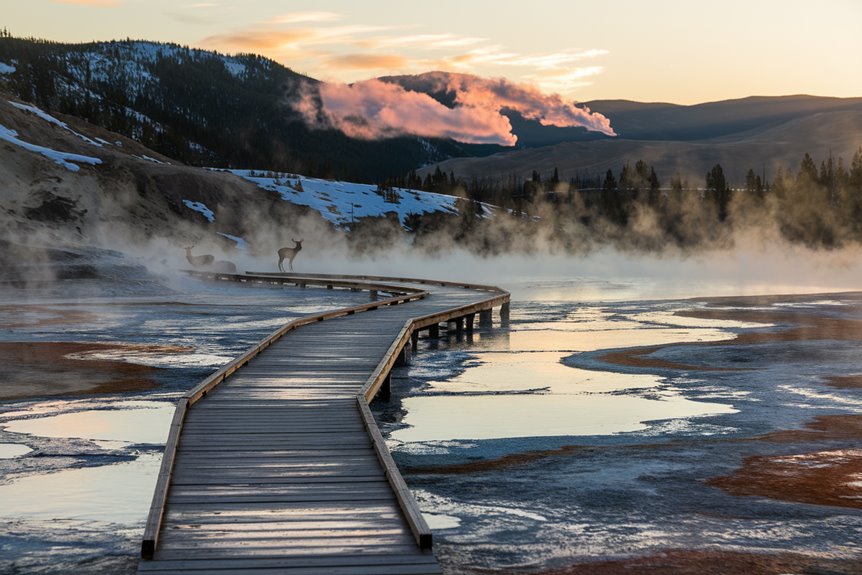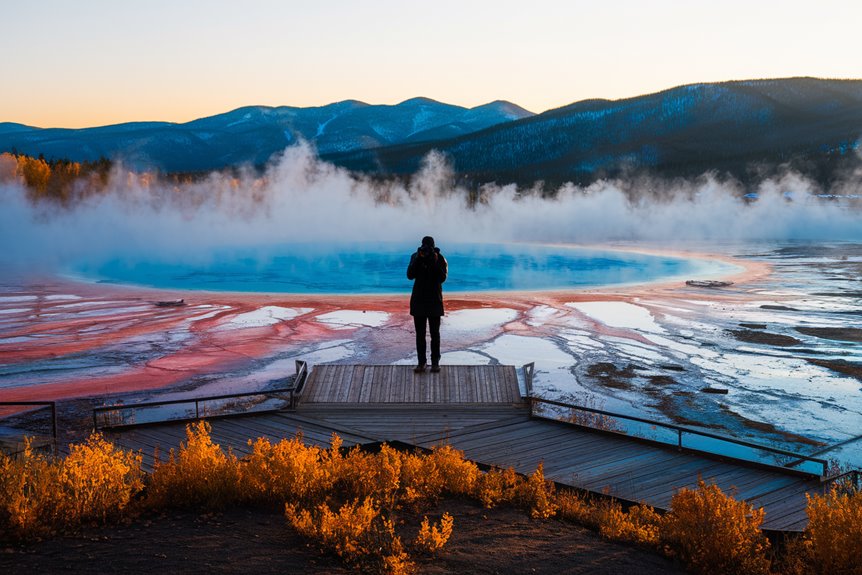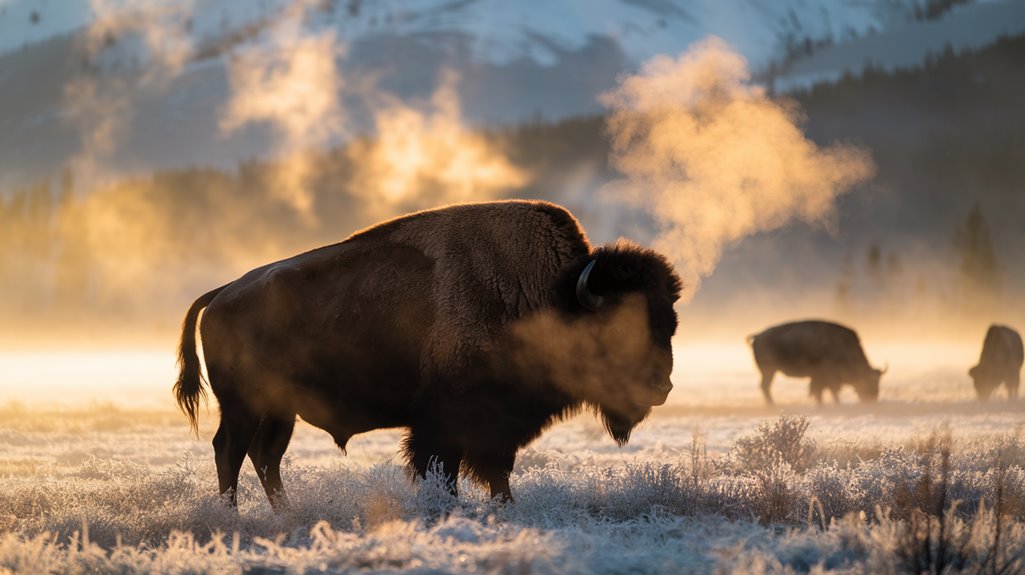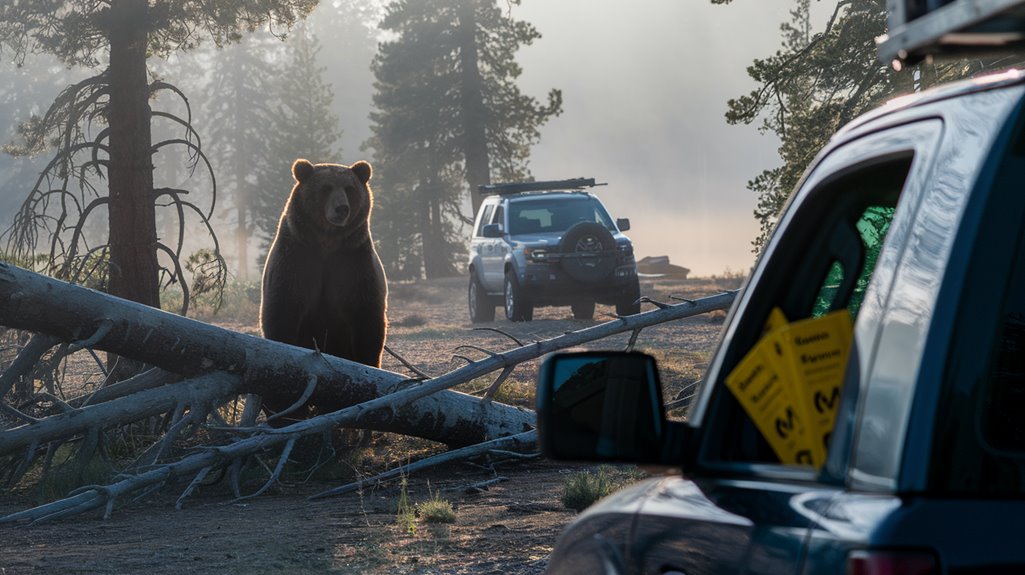You've probably heard about Yellowstone's peak summer season, with its crowded boardwalks and packed parking lots. But there's another side to America's first national park that you won't encounter in July or August. During the shoulder and off-seasons, you'll find a different Yellowstone: one where steam from geothermal features hangs heavier in the crisp air, where elk bugles echo through empty valleys, and where you can stand alone at Old Faithful's edge. Whether you're planning for spring's wildflower blooms or winter's pristine snowscapes, understanding the nuances of off-season travel will transform your Yellowstone adventure.
Key Takeaways
- Spring (April-May) and Fall (September-October) offer ideal shoulder seasons with mild weather and fewer crowds for exploring Yellowstone.
- Winter activities include cross-country skiing, snowcoach tours, and prime wolf-watching opportunities in Lamar Valley.
- Road access is limited during off-season, with only one year-round route from Mammoth Hot Springs to Northeast Entrance.
- Off-season wildlife viewing excels during dawn and dusk, featuring bears, wolves, and seasonal animal behaviors like elk rutting.
- Shoulder season temperatures vary significantly, requiring layered clothing and preparation for both mild days and potential snowfall.
When To Visit Yellowstone

Timing your visit to Yellowstone can make or break your national park escapade. If you're looking to avoid crowds, plan your trip during spring (April-May) or fall (September-October).
September provides comfortable hiking weather and abundant wildlife viewing opportunities, while early October treats you to stunning autumn colors.
For the most tranquil encounter, consider visiting in early June before peak summer crowds arrive. You'll find relatively fair weather and better access to popular geothermal features.
If you're interested in wildlife photography, schedule your visit between late May and early June. For baby animal sightings, aim for late April through mid-June.
Keep in mind that winter visits (November-March) require extra planning due to road closures and limited access, though you'll have unique opportunities for activities like cross-country skiing and snowshoeing.
Weather and Seasonal Changes
Each season in Yellowstone brings its own distinct weather patterns that'll shape your park encounter.
In spring, you'll face temperatures from 30°F to 60°F, with overnight lows dipping into single digits and frequent snowfall of up to 12 inches.
Summer presents milder conditions, with temperatures reaching 70°F to 80°F, though afternoon thunderstorms are common.
Fall brings pleasant daytime temperatures in the 50s to mid-70s, but you'll need to prepare for cold nights and potential snowfall.
Winter is the most extreme season, with temperatures ranging from 0°F to 20°F and frequent sub-zero readings, particularly at higher elevations.
You'll encounter substantial snowfall, averaging 150 inches annually, with some areas receiving double that amount.
Remember that Yellowstone's weather can change rapidly in any season, so pack accordingly.
Must-Do Activities

While Yellowstone's weather patterns set the stage for your visit, the park's off-season activities offer unique encounters you won't find during peak months.
You'll uncover pristine snow-covered landscapes perfect for cross-country skiing and snowshoeing at Specimen Creek or Bighorn Pass. Take a guided snowcoach tour to safely explore remote areas, or join a ranger-led program to enhance your winter wildlife viewing opportunities.
- Book a professional guide through Yellowstone Forever for expert-led snowshoe expeditions
- Engage in wolf watching in the Northern Range, where wildlife is most active
- Join a snowmobile tour to access deep powder areas with stunning winter vistas
- Try ice skating at Mammoth Hot Springs Hotel for a classic winter activity
- Combine your visit with nearby world-class skiing at Big Sky or Jackson Hole
Wildlife Viewing Opportunities
Yellowstone's off-season opens up extraordinary wildlife viewing opportunities across all four seasons, with each period presenting its own unique encounters.
Spring brings an abundance of newborn animals, with bison calves, fox kits, and bear cubs emerging alongside their mothers. You'll find the best viewing in Lamar and Hayden Valleys, particularly during dawn and dusk.
Fall showcases the dramatic elk rut, while bears actively forage before hibernation.
Winter transforms into a prime season for wolf watching, especially in Lamar Valley. You'll spot bison and elk easily against the snow-white backdrop, and guided snowmobile tours offer excellent access to wildlife areas.
While summer can be challenging due to crowds pushing animals away, you'll still find opportunities in higher elevations near Canyon and Mount Washburn, especially during early morning hours.
Road Access and Transportation

Throughout Yellowstone's off-season, road access becomes considerably limited, with only one year-round route remaining open between Mammoth Hot Springs and the Northeast Entrance via Lamar Valley.
You'll need to plan your transportation carefully, as most park roads close to private vehicles from early November through late April. During winter months, you can access interior areas via snowcoaches or guided snowmobile tours, which run regularly between major locations like Mammoth Hot Springs Hotel and Old Faithful Snow Lodge.
- Bozeman Yellowstone International Airport (BZN) provides year-round flights with shuttle services to key park locations
- You can check current road conditions by calling 307-344-2117 or signing up for SMS alerts
- Advance reservations are required for all shuttle and snowcoach services
- Non-commercially guided snowmobile access is available through a special permit program
- Local taxis operate year-round from West Yellowstone to designated park locations
Essential Planning Tips
Planning a successful off-season visit to Yellowstone requires careful attention to several key factors.
You'll need to prepare for variable weather conditions by packing layered clothing, winter boots, and waterproof gear, especially for single-digit temperatures and icy conditions common in spring and fall.
Choose your activities based on the season – try hiking and biking in April and October, or opt for snowshoeing and skiing in the Northwest corner during winter months.
September through April provides excellent wildlife viewing opportunities. To avoid crowds, arrive early at popular sites and consider exploring lesser-known landmarks.
Keep in mind that many facilities close during off-season, though the North Entrance remains accessible year-round.
Always check the park's website for current conditions, road closures, and facility operations before your visit.
Frequently Asked Questions
Are Laundry Facilities Available in the Park During Shoulder Seasons?
While summer's warmth fades to autumn's coolness, you'll find laundry facilities still running at Canyon, Grant, and Fishing Bridge until late September. Hours may be limited, so check specific locations for availability.
Can I Rent Camping Gear From Facilities Near Park Entrances?
Yes, you can rent camping gear near park entrances at Mammoth Hot Springs, Old Faithful Visitor Center, and Canyon Village. They'll provide everything from tents to cooking equipment during their regular business hours.
Which Off-Season Locations Offer the Best Cell Phone Coverage?
Like beacons in the wilderness, Old Faithful and Mammoth Hot Springs offer you the strongest cell signals. You'll also find reliable coverage at Grant Village, Canyon, and Tower-Roosevelt, where towers stand guard year-round.
Are Ranger-Led Programs Still Available During Shoulder Seasons?
Yes, you'll find ranger-led programs available during shoulder seasons, but with limited options compared to peak season. It's best to check visitor centers, the NPS App, or park newspaper for current program schedules.
What Backup Plans Should I Have if Sudden Weather Changes Occur?
Ever been caught in unexpected weather? Pack warm layers, keep emergency supplies handy, save backup lodging contacts, monitor weather alerts, and you'll want alternative routes mapped out. Don't forget your emergency communication devices.


